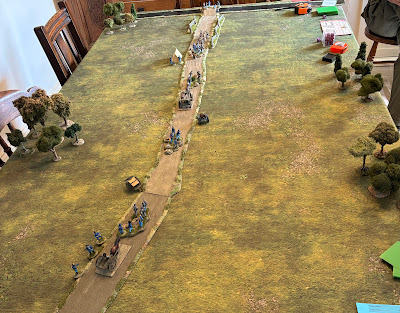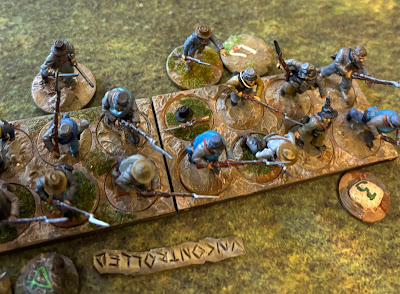On Saturday I had Ron and Mark come over to try a first playtest of
Running from Bull Run with live victims... sorry, volunteers.
This was the first time I'd set up the game on a 6'x4' table.
Running along the table is the Warrenton Turnpike, at the far end of which is the Cub Run where some Union engineers were working on the bridge.
It turned out that Ron had driven along this road a few years ago. Mark and I learned some interesting stuff about the operation of toll roads in the USA!
The game began with various wagons strung out along the road and among them four clumps of fleeing Union soldiers. As the Union player, Mark's aim was to organise them into a coherent rearguard. By doing so he might perhaps salvage some personal renown from the disaster and maybe mark himself out for higher command later in the conflict.
Ron's role was that of Fate. He would control all of those factors conspiring to make life difficult for the retreating boys in blue (and often grey too - in these early days of the war national uniform colours have yet to become established).
One such factor that made an early appearance (determined by Ron's drawing Event Cards) was the Black Horse Cavalry. This greatly feared confederate unit caused a couple of groups of Union soldiers to rout in panic before they were revealed to be in fact stampeding artillery draft horses!
Despite this, Mark did manage to organise some Union units into, albeit fragile, fighting stance. This was just in time as Sergeant Dexter Slab turned up with a group of Confederate infantry.
Mark thought the two Groups of Union infantry he'd managed to rally could take on Slab's Rebs, particularly if he could rally off some more Shock before the range closed too much.
Unfortunately at this point the Union commander's status was somewhat reduced when he trod in a pile of day-old racoon shit.
 |
The bandage marker indicates the leader's
reduced status |
Mark was some what peeved...
Fortunately Mark was able to get a couple of stragglers from the 13th New York to manhandle over an abandoned water bowser and clean off the crap!
As Mark got his Union battle line formed up they found themselves facing a similar Confederate formation let by Lt Jessop West.
It looked like the Confederates, with an advantage in terms of the amount of Shock taken, would be victorious in the coming firefight but then they fell victim to a "damp powder" random event.
 |
The "fouled barrels" marker doing duty to
show "damp powder".
|
Another Union group joined in from the turnpike.
Lt West was injured by a stray Minié ball.
In the end, after about four hours of leisurely play (including tea breaks) we reached to end of the scenario with the exhaustion of the Event Card deck. Counting the ratio of routed or dead Union troops to rallied ones, I declared a Confederate victory.
It's very difficult, after just a couple of test runs, to have a real handle on the balance of the scenario in terms of either side being able to win but I'm reasonably happy with the way the victory conditions incentivise play that recreates the historical narrative.
I'll be making a few tweaks to the scenario before the next test:
- Restructuring the game as two Union players versus two Fate players,
- Adding a fourth Union Leader (a sergeant with a special knack for finding stragglers),
- Reducing the card count slightly by adding one of the late-arriving wagons to the initial traffic jam, and
- Creating some more options for the Fate players when it comes to using command flags.
































